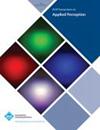使用消费级脑机接口检测潜意识人脸识别
IF 1.9
4区 计算机科学
Q3 COMPUTER SCIENCE, SOFTWARE ENGINEERING
引用次数: 20
摘要
我们使用消费级脑机接口测试挖掘潜意识进行人脸识别的可能性。为此,我们进行了一项实验,向受试者展示名人的照片,期望其中约20%的人会(有意识地)认出来;由于这些照片都是名人,我们预计受试者之前会看到他们没有(有意识地)认识的80%中的一些人。此外,我们预计他们的潜意识会认出他们之前见过的80%池中的一些人。一份退出问卷和一套标准让我们将认知分为有意识的、错误的、没有认知的和潜意识的认知。我们分析了一些事件相关的电位训练和测试的支持向量机。我们发现我们的方法能够区分无识别和潜意识识别,并且准确率很高,这表明利用潜意识进行人脸识别是可行的。本文章由计算机程序翻译,如有差异,请以英文原文为准。
Detection of Subconscious Face Recognition Using Consumer-Grade Brain-Computer Interfaces
We test the possibility of tapping the subconscious mind for face recognition using consumer-grade BCIs. To this end, we performed an experiment whereby subjects were presented with photographs of famous persons with the expectation that about 20% of them would be (consciously) recognized; and since the photos are of famous persons, we expected that subjects would have seen before some of the 80% they didn’t (consciously) recognize. Further, we expected that their subconscious would have recognized some of those in the 80% pool that they had seen before. An exit questionnaire and a set of criteria allowed us to label recognitions as conscious, false, no recognitions, or subconscious recognitions. We analyzed a number of event related potentials training and testing a support vector machine. We found that our method is capable of differentiating between no recognitions and subconscious recognitions with promising accuracy levels, suggesting that tapping the subconscious mind for face recognition is feasible.
求助全文
通过发布文献求助,成功后即可免费获取论文全文。
去求助
来源期刊

ACM Transactions on Applied Perception
工程技术-计算机:软件工程
CiteScore
3.70
自引率
0.00%
发文量
22
审稿时长
12 months
期刊介绍:
ACM Transactions on Applied Perception (TAP) aims to strengthen the synergy between computer science and psychology/perception by publishing top quality papers that help to unify research in these fields.
The journal publishes inter-disciplinary research of significant and lasting value in any topic area that spans both Computer Science and Perceptual Psychology. All papers must incorporate both perceptual and computer science components.
 求助内容:
求助内容: 应助结果提醒方式:
应助结果提醒方式:


